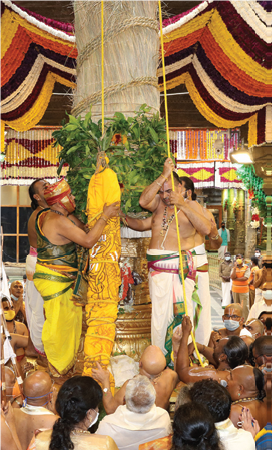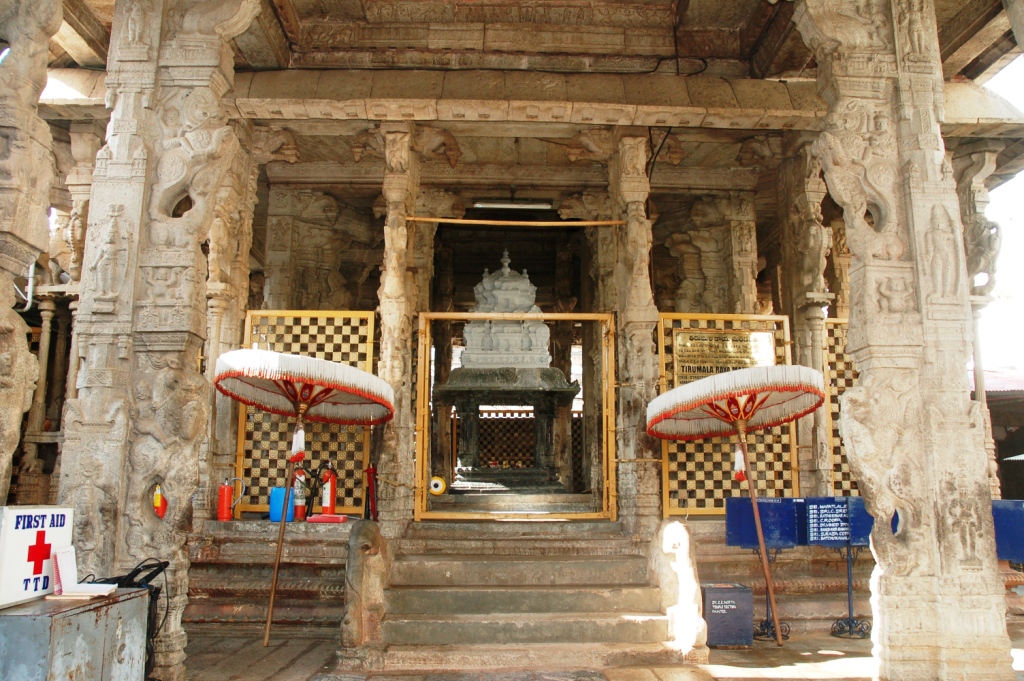Mandapams of Tirumala
The lush green forests of Seshachala house, Sri Venkateswara Swamy, who is also revered as Perumal, Venkatachalapati, Tirumalesa, Govinda, Balaji, Srinivasa and many more names.
The ancient temple of Lord Venkateswara in the hill shrine of Tirumala is an amazing complex of history, culture, and traditions. Almost every brick speaks volumes about the cultural journey of the temple over the past several centuries.
Let us explore Tirumala Raya mandapam or Anna Unjal mandapam.
Tirumala Raya Mandapam or Anna Unjal mandapam
Next to the Rangamantapam and at a distance of 12 feet from the east prakaram wall of the inner gopuram, is another mantapa measuring 40 feet east to west and about 80 feet north to south. This is known as Tirumala Raya mandapam or Anna Unjal mandapam. This consists of two parts constructed at different periods, the front part being at the lower level and the back at a higher.
The southern or inner portion measuring 10 ft. – 45ft, has a more elevated basement than the front one and is traditionally attributed to Saluva Narasimha of 1473 A.D. for celebrating the Anna Unjal Tirunal instituted by him in that year.
This structure was renovated and extended to its present size and shape by Araviti Bukkaraya Ramaraja, Sriranga. Raja, Tirumala Raja in the last quarter of the 16th century. In this mandapa other festivals like the vasanta utsava were celebrated during the time of Tirumala raja.
It is in this mandapa that the processional deity malayappan, holds his annual darbar of asthana on the hoisting of the garuda dhvaja on the top of the dhvajastambam to mark the commencement of the Brahmotsavam.

The prasadam distribution on this occasion is still called Tirumalarayan pongal, although the endowment made by that emperor has long ago disappeared. This mandapam practically touches the dhwajastamba mantapam
Saluva Narasimha who constructed the southern portion of this mandapam saved the kingdom from anarchy soon after the assassination of Virupaksha-II and who gave stability to the kingdom for nearly 40 years, was a great warrior. As a devout Vaishnava, he has given many important benefactions to the temple.
He had the full assistance and support of Kandadi Ramanuja Ayyangar who figures frequently in the inscriptions of Saluva Narasimha, and who in addition to being a patron of poets like Ranganatha Dindima, was himself a well-known author and has a book Ramabhyudaya to his credit.
His queen Sriranga Devi and other members of the royal family also gave several endowments to the temple. In 1485 A.D. he built a shrine for Laxmi Narasimha on the pathway to the Seshadri hills (GT-273).
This mandapam has a typical Vijayanagara complex of pillars, with a central pillar surrounded by smaller pillarets, some of which emit musical sounds when struck with a stone. The main pillars have rearing horses with mounted warriors. Some of the best sculptures of the temple are found in bold relief in this mandapa.
The pillars in the two outer rows are plain while those in the interior have animal brackets. In the back part of the mandapa also there are two rows of four pillars each on each side. The pavilion in black granite in the middle of the mandapa has in the corners four pillars each with three pillarets projecting.
In one corner of the Tirumala Raya Mandapam are kept the bronze statues of Todaramalla, his mother Matha Mohana De, and his wife Pitha Bibi. As in the case of Krishnadevaraya bronzes, the names are inscribed on their shoulders.
Todarmalla was in charge of the Karnatak area on behalf of the Nawabs of Golconda in the beginning years of the 18th century. He was a general under the Nawabs of Karnatak.
Srivari temple – Mandapams
According to saint poet Sri Tallapaka Annamayya, the various Mandapams and constructions inside the Srivari temple served as shelters to the devotees at times of heavy rains and scorching summer besides being served as platforms for temple rituals and stand here to tell the volumes of history.
These temples not only have historical and mythological significance but also stand as architectural marvels. A peep into these mandapams:
- Dwajasthambha mandapam,
- Krishnadevaraya Mandapam,
- Four Pillar Mandapam,
- Ranganayakula Mandapam or Ranga Mandapam,
- Kalyanotsava Mandapam,
- Addala Mandapam or Aina Mahal,
- Garuda Mandapam,
- Golla Mandapam,
- Sahasra Deepalankara Seva Mandapam etc.

